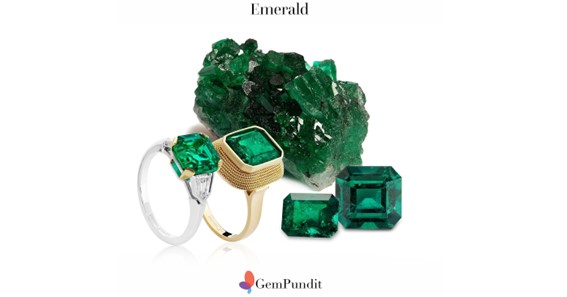Within the vast world of gemstones, emeralds stand out for their enchanting green hue and timeless allure. However, the market is rife with imitation and synthetic alternatives, making it challenging to differentiate between an original emerald stone ring and a counterfeit.
When it comes to identifying an original emerald stone ring, one of the primary factors to consider is the gemstone itself. Natural emeralds, formed over millions of years, possess unique internal flaws known as “jardin” or “garden.” These visible imperfections, such as tiny cracks, cloudiness, or feather-like inclusions, serve as a tell-tale sign of a genuine emerald’s natural origin. You can find such authentic stones on a reputable portal like GemPundit.
Here are some ways to identify an original emerald stone for your ring.
Decoding the Color: Hues, Tones, and Internal Fire
The color of an emerald is its most defining characteristic, and understanding the intricacies of hues, tones, and internal fire will aid in determining its authenticity.
Genuine emeralds exhibit a captivating range of green hues, from deep and rich forest greens to lighter shades with subtle yellow or blue undertones. The stone should appear vibrant and intense, evoking a sense of natural beauty. Counterfeit emeralds or synthetic alternatives often lack the nuanced variations found in authentic stones, presenting a more uniform and artificial color.
Beyond the hue, the tone of the emerald is equally significant. It refers to the lightness or darkness of the green color. Authentic emeralds can have various tones, from light to dark, with each tone possessing its own unique charm. A genuine emerald will showcase a well-balanced and consistent tone throughout the stone.
Assessing Transparency and Luster
Transparency refers to the degree to which light can pass through the emerald. Authentic emeralds often exhibit a level of transparency that allows light to penetrate the stone, creating a sense of depth and enhancing its visual appeal. However, it’s important to note that emeralds are rarely completely transparent due to the presence of natural inclusions.
While some inclusions are expected in genuine emeralds, excessive cloudiness or lack of transparency may indicate a lower quality or a potential synthetic or treated stone.
Luster refers to the shine or brilliance of the emerald’s surface. A high-quality emerald will display a captivating luster that reflects light evenly across its facets, giving it a vibrant and radiant appearance. It should be consistent throughout the stone, without any dull or lifeless areas. Be cautious of emeralds with an overly dull or glassy appearance, as they may indicate a lower quality or non-genuine gem.
When assessing transparency and luster, it’s advisable to examine the emerald stone under different lighting conditions, such as natural daylight and various indoor lighting sources. This allows you to observe how the gemstone interacts with light and assess its visual characteristics from multiple angles.
Evaluating the Cut and Shape of the Emerald
The cut and shape of the emerald not only contribute to its overall aesthetics but also reflect the expertise of the gem cutter and can indicate the authenticity of the stone.
The cut of an emerald refers to the gemstone’s faceting and proportions. A well-cut emerald will exhibit symmetrical facets that interact with light to enhance the stone’s brilliance and fire. The facets should be carefully aligned and positioned to maximize the gem’s natural beauty.
Irregular or poorly executed cuts can diminish the emerald’s visual appeal and indicate a lack of craftsmanship. Additionally, the cut should be appropriate for the specific shape of the emerald, allowing the stone to showcase its inherent characteristics.
The shape of an emerald stone can vary, with rectangular or square cuts being the most common. However, emeralds can also be found in other shapes such as oval, round, pear, or even unique custom cuts. Focus on the precision and consistency of the shape. Authentic emeralds will exhibit clean lines and well-defined edges, indicating careful cutting and polishing.
Click here – Here’s Why You Should Invest in Quarter Ounce Gold Coins
Trusted Sources and Reputable Retailers for Original Emerald Rings
The market is filled with various sellers, both online and offline, making it crucial to identify trusted sources that prioritize authenticity and provide genuine emerald jewelry. Here are some factors to consider when seeking reputable retailers:
- Established Gemstone Dealers: Look for well-established gemstone dealers with a long-standing reputation for dealing in authentic and high-quality emeralds.
- Certification and Documentation: Look for certifications from renowned gemological laboratories, such as GIA (Gemological Institute of America) or AGS (American Gem Society), which verify the authenticity and quality of the gemstones.
- Customer Reviews and Recommendations: Trusted retailers will have positive feedback from satisfied customers who can attest to the authenticity and quality of their emerald rings.
- Knowledgeable Staff: They should be able to share detailed information about the gemstone’s characteristics, origins, and the factors that determine its quality.
- Return and Refund Policies: The seller should have clear return and refund policies, offering you the assurance that you can return the emerald ring if it doesn’t meet your expectations or if any authenticity concerns arise.
When considering purchasing an original emerald stone ring, do thorough research, compare different retailers, and opt for those with a strong reputation in the industry.
